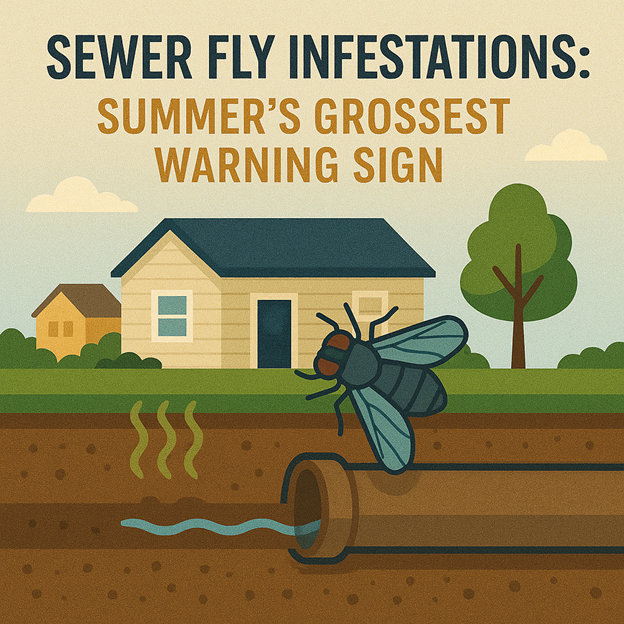Summer in Fort Wayne brings backyard BBQs, sunshine — and, unfortunately, sewer flies. Also known as drain flies or moth flies, these tiny winged pests are more than just annoying. They’re often the first warning sign of a larger, hidden issue in your plumbing system. If you’ve spotted these bugs hovering near your sinks, showers, or basement drains, it’s time to take action.
This guide breaks down everything Fort Wayne homeowners need to know about sewer fly infestations: what causes them, how to eliminate them, and how to stop them from coming back.
1. What Are Sewer Flies — And Why They Love Your Drains
- Sewer flies are small, fuzzy-winged insects, typically gray or black, about 1/8 inch long
- They breed in moist, decaying organic matter — making your drain lines, sump pits, and floor traps ideal homes
- Larvae thrive in the slimy biofilm that builds up inside pipes
- They don’t bite or sting, but they reproduce rapidly and signal the presence of sludge or standing wastewater
Key Visual Clues:
- Flies hovering near bathroom or kitchen drains
- Clusters of tiny bugs on walls near plumbing
- Dark smears or tiny insect droppings around sink rims
2. Why Summer Makes Sewer Fly Problems Worse
- Heat and humidity accelerate organic decay inside pipes, speeding up fly reproduction
- Seasonal increase in water usage (showers, laundry, garden hoses) promotes damp conditions ideal for larvae
- Outdoor drains, sump pumps, and yard basins may collect stagnant water — perfect breeding grounds
Fort Wayne homes with older or clay sewer lines are especially vulnerable, as cracks and debris can trap waste and moisture.
3. Signs Your Plumbing May Be the Problem
Sewer flies often indicate deeper issues:
- Slow drains: Standing water allows biofilm to form
- Gurgling sounds: May suggest partial blockages or improper venting
- Basement or crawlspace moisture: Leaking or overflowing drains feed fly habitats
- Recurring fly swarms even after cleaning: Problem likely deeper in the sewer line or p-traps
4. How to Eliminate Sewer Flies at the Source
Step 1: Identify Breeding Sites
- Place clear tape over drains at night (sticky side down); check for trapped flies in the morning
- Inspect utility sinks, basement floor drains, sump pump basins, and unused bathrooms
Step 2: Clean Drain Biofilm
- Pour boiling water daily into infested drains for 3–5 days
- Scrub pipe sides with a long brush and enzymatic cleaner
- Use a foaming drain treatment that coats the entire inner pipe wall
Step 3: Address Underlying Issues
- Fix slow drains, backups, or minor leaks
- Ensure traps stay filled with water — dry traps allow pests and gases to enter
- Have a sewer camera inspection to check for cracked pipes, pooling wastewater, or hidden clogs
5. What Doesn’t Work (and May Make It Worse)
- Bleach: Doesn’t penetrate biofilm and can damage pipes
- Bug sprays: Only kill surface flies — not larvae inside pipes
- Ignoring the problem: Infestations often multiply rapidly, and flies can spread to other areas of the home
6. Long-Term Prevention Strategies
- Treat problem drains monthly with enzyme-based cleaners
- Seal cracks in basement floors or utility rooms where moisture can collect
- Keep outdoor drains and sump pump pits clear of debris
- Schedule routine drain cleaning to remove organic buildup before flies appear
Bonus Tip: Maintain Unused Drains
- Pour water down rarely used drains (e.g., basement, guest bath) every few weeks to keep traps sealed
- Add a teaspoon of mineral oil to slow evaporation in floor drains
Fort Wayne Fact:
Many homes in Fort Wayne’s historic neighborhoods have cast iron or clay sewer lines with decades of organic buildup. These older pipes are prime breeding grounds for sewer flies — especially during the hot, humid Indiana summer.
Stop the Swarm Before It Starts
Sewer flies are gross — but they’re also useful messengers. When they show up, it’s a clear sign that something deeper in your plumbing system needs attention. AAA Sewer Service specializes in identifying and eliminating sewer fly causes with high-resolution camera inspections, drain jetting, and targeted maintenance solutions.
📞 Call AAA Sewer Service at (260) 456-6930
🌐 Visit our website: www.aaasewerservice.com

